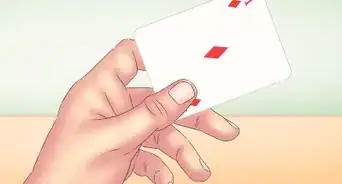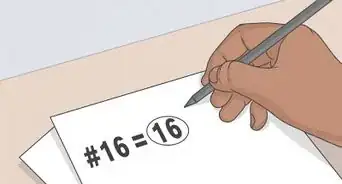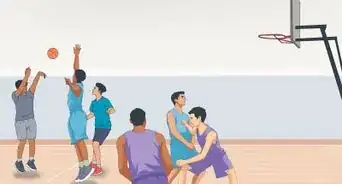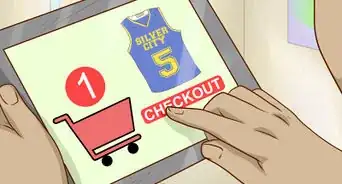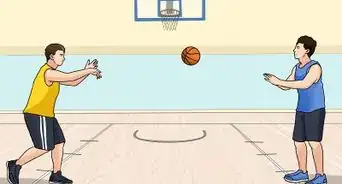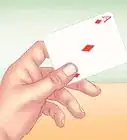This article was co-authored by wikiHow Staff. Our trained team of editors and researchers validate articles for accuracy and comprehensiveness. wikiHow's Content Management Team carefully monitors the work from our editorial staff to ensure that each article is backed by trusted research and meets our high quality standards.
This article has been viewed 127,668 times.
Learn more...
21 is a simplified version of basketball that keeps most of the standard rules. You can play it just about anywhere you have access to a basketball hoop. It's really easy to learn how to prepare, how to play the game, or how to handle the rules. You can play according to the basic rules or mix things up a bit after you’ve gotten the hang of it.
Note: If you're looking for tips on playing Blackjack, check out this wikiHow article.
Steps
Preparing to Play
-
1Find other players. Round up two or more people. Each person is their own team. Everyone keeps track of their own score.[1]
-
2Designate the free-throw line. On a regulation basketball court, this is a straight horizontal line. Usually, this is 15 feet (4.6 m) from the basket.[2] However, if you’re playing on a driveway or smaller court, you can improvise.Advertisement
-
3Designate the 3-point line. This is the large semi-circle that encloses the free-throw line on a regulation court. Usually, this is 23.75 feet (7.24 m) from the basket.[3] Feel free to improvise on a smaller court.
-
4Establish the rules. Every game of 21 has its basic rules. However, you and the other players can make adjustments to create a challenge or make things easier for beginners.[4] Some common rules are:
- Regular shots are worth 2 points each. You can make them anywhere on the court except the free-throw or 3-point line.
- 3-point shots are worth 3 points each. Make them from the 3-point line.
- Free-throw shots are worth 1 point each. Make them from the free-throw line.[5]
Playing the Game
-
1Determine who takes the first shot. Take turns shooting at the hoop rim. The first person to hit the rim takes possession of the ball. You could adjust this rule so that you have to get the ball in the basket in order to take possession.
-
2
-
3Get extra shots. Each 2-point shot you make earns you a 1-point shot from the free-throw line. After you make 3 shots in a row, one of your opponents can check you in a one-on-one match-up. If you make that shot, you get 2 points.
- If you miss your free throw, try to stop your opponents from putting the ball back in the basket.
-
4
-
5Continue the game. Shoot additional 1- 2-, and 3-point shots until someone gets 21 points. In basic rules, the first player to 21 wins. You could end the game there or have a rematch.
Playing by New Rules
-
1Penalize tip-ins. In a tip-in, one player shoots the ball toward the basket but misses. Meanwhile, another player jumps, catches the ball, and scores before it hits the ground.[9] Make the game more challenging by reducing the score of the “tipped” shooter (the one who missed their shot).
- You can reduce it to 13 or a lower number if the player has less than 13 points. To make it even more interesting, reduce the score to zero.
-
2Don’t stop at 21 points. Make a rule that the winner must have at least 21 points and lead by a set number of points. For example, you could agree to continue beyond 21 points until someone leads by 2, 4, or more points.
-
3Penalize a missed free-throw. Sometimes, a player will have to make a free-throw shot in order to make it to 21. If they miss, their score gets rolled back to 13 points.
Expert Q&A
-
QuestionWhat do you do if you are nervous before a game?
 Ryan TremblayRyan Tremblay is a Basketball Coach and the Owner of National Sports ID and STACK Basketball. With over 30 years of experience, Ryan specializes in basketball coaching, social media marketing, and website design. Ryan created the National Sports ID as a platform to verify the age/grade of youth athletes and STACK Basketball to inspire young athletes to grow into mature individuals and basketball players. Ryan was a First Team All-Decade basketball player in Bergen County and finished in the top 20 all-time leading scorers in the county’s history with 1,730 points. He went on to Caldwell University on a basketball scholarship where he was part of three championship teams. Ryan was a two-time All-Metropolitan, All-State, and All-Conference point guard and the all-time three-point leader in the school’s history, landing him in the Caldwell University Athletic Hall of Fame.
Ryan TremblayRyan Tremblay is a Basketball Coach and the Owner of National Sports ID and STACK Basketball. With over 30 years of experience, Ryan specializes in basketball coaching, social media marketing, and website design. Ryan created the National Sports ID as a platform to verify the age/grade of youth athletes and STACK Basketball to inspire young athletes to grow into mature individuals and basketball players. Ryan was a First Team All-Decade basketball player in Bergen County and finished in the top 20 all-time leading scorers in the county’s history with 1,730 points. He went on to Caldwell University on a basketball scholarship where he was part of three championship teams. Ryan was a two-time All-Metropolitan, All-State, and All-Conference point guard and the all-time three-point leader in the school’s history, landing him in the Caldwell University Athletic Hall of Fame.
Basketball Coach Don't worry about it—it's actually good to feel nervous! Feeling nervous means that you're ready for the game.
Don't worry about it—it's actually good to feel nervous! Feeling nervous means that you're ready for the game.
Warnings
- A basketball to the face hurts, so watch out!⧼thumbs_response⧽
References
- ↑ https://www.lifetime.com/customerservice/tipsandsolutionsdetail/592/5-familyfun-basketball-games
- ↑ https://www.youtube.com/watch?v=xNHFNGfVlSY
- ↑ https://www.youtube.com/watch?v=tmKnAvShmlI
- ↑ http://www.youtube.com/watch?v=eEhlknbzV5Q
- ↑ https://www.lifetime.com/customerservice/tipsandsolutionsdetail/592/5-familyfun-basketball-games
- ↑ https://www.lifetime.com/customerservice/tipsandsolutionsdetail/592/5-familyfun-basketball-games
- ↑ http://www.csuci.edu/recreation/basicbasketballrules.pdf
- ↑ https://www.lifetime.com/customerservice/tipsandsolutionsdetail/592/5-familyfun-basketball-games
- ↑ https://www.youtube.com/watch?v=2NcBOaYzRf4
About This Article
21 is a variation of basketball played with 2 or more players. It’s a popular version of basketball at public courts because it only requires one hoop, and players can join and leave the game as they please. The goal of the game is always to be the first player to score 21 points. There are no teams in 21, and every player is competing with one another. In general, every bucket scored inside of the 3-point line is worth 1 point. If you are playing with a 3-point line, anyone who scores outside of that line is awarded 2 points. When a player scores, they go to the free throw line. Each made free throw is worth 1 point, and after 3 consecutive makes, they take the ball back out past the 3-point line and attempt to score again. Whenever a player misses, if the ball hits the rim, the rebounding player must take the ball out past the 3-point line to “clear it” before they can attempt to score. If the ball doesn’t hit the rim, the rebounding player is allowed to score right away. Keep in mind, there is typically a series of unspoken rules in 21. In many variations, only one player plays defense outside of the paint; this role is typically assumed by the last player to miss, but other players will often step in to block shots if a player attempts to drive to the rim. Another common variation of the game involves your score going back to 11 points if you accidentally score more than 21 points, although some variations simply require you to win by 2 points. There are no fouls or boundary lines in most games, although players typically abide by normal street ball rules where fouls are to be called by the fouled player if they perceive an obvious foul. For more advice, like how to make the game more difficult with extra rules, read on!
-Step-1.webp)
-Step-2.webp)
-Step-3.webp)
-Step-4.webp)
-Step-5.webp)
-Step-6.webp)
-Step-7.webp)
-Step-8.webp)
-Step-9.webp)
-Step-10.webp)
-Step-11.webp)
-Step-12.webp)
